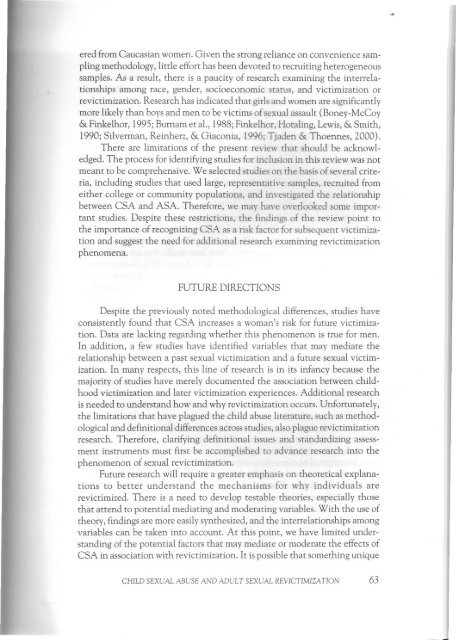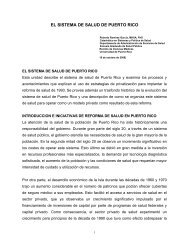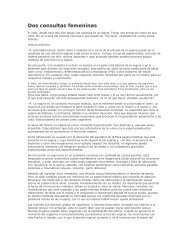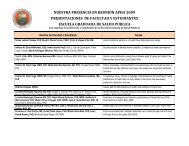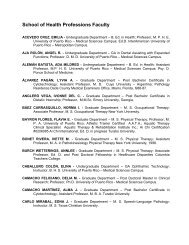CHILD SEXUAL ABUSE AND ADULT SEXUAL REVICTIMIZATION
CHILD SEXUAL ABUSE AND ADULT SEXUAL REVICTIMIZATION
CHILD SEXUAL ABUSE AND ADULT SEXUAL REVICTIMIZATION
You also want an ePaper? Increase the reach of your titles
YUMPU automatically turns print PDFs into web optimized ePapers that Google loves.
ered from Caucasian women. Given the strong reliance on convenience sam~<br />
pling methodology, little effort has been devoted to recruiting heterogeneous<br />
samples. As a result, there is a paucity of research examining the interrela~<br />
tionships among race, gender, socioeconomic status, and victimization or<br />
revictimization. Research has indicated that girls and women are significantly<br />
more likely than boys and men to be victims of sexual assault (Boney~McCoy<br />
& Finkelhor, 1995; BumametaL, 1988; Finkelhor, Hotaling, Lewis, & Smith,<br />
1990; Silverman, Reinherz, & Giaconia, 1996; Tjaden & Thoennes, 2000).<br />
There are limitations of the present review that should be acknowl~<br />
edged. The process for identifying studies for inclusion in this review was not<br />
meant to be comprehensive. We selected studies on the basis of several crite~<br />
ria, including studies that used large, representative samples, recruited from<br />
either college or community populations, and investigated the relationship<br />
between CSA and ASA. Therefore, we may have overlooked some impor~<br />
tant studies. Despite these restrictions, the findings of the review point to<br />
the importance of recognizing CSA as a risk factor for subsequent victimiza~<br />
tion and suggest the need for additional research examining revictimization<br />
phenomena.<br />
FUTURE DIRECTIONS<br />
Despite the previously noted methodological differences, studies have<br />
consistently found that CSA increases a woman's risk for future victimiza~<br />
tion. Data are lacking regarding whether this phenomenon is true for men.<br />
In addition, a few studies have identified variables that may mediate the<br />
relationship between a past sexual victimization and a future sexual victim~<br />
ization. In many respects, this line of research is in its infancy because the<br />
majority of studies have merely documented the association between child~<br />
hood victimization and later victimization experiences. Additional research<br />
isneeded to understand how and why revictimization occurs. Unfortunately,<br />
the limitations that have plagued the child abuse literature, such as method~<br />
ologicaland definitional differencesacrossstudies,alsoplague revictimization<br />
research. Therefore, clarifying definitional issues and standardizing assess~<br />
ment instruments must first be accomplished to advance research into the<br />
phenomenon of sexual revictimization.<br />
Future research will require a greater emphasis on theoretical explana~<br />
tions to better understand the mechanisms for why individuals are<br />
revictimized. There is a need to develop testable theories, especially those<br />
that attend to potential mediating and moderating variables. With the use of<br />
theory, findings are more easilysynthesized,and the interrelationships among<br />
variables can be taken into account. At this point, we have limited under~<br />
standing of the potential factors that may mediate or moderate the effects of<br />
CSA in association with revictimization. It ispossible that something unique<br />
<strong>CHILD</strong> <strong>SEXUAL</strong> <strong>ABUSE</strong> <strong>AND</strong> <strong>ADULT</strong> <strong>SEXUAL</strong> <strong>REVICTIMIZATION</strong> 63


